|
3/30/2017 0 Comments Short Story Review - Overview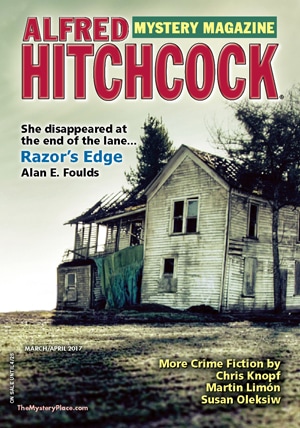 There are many short mystery fiction options out there, from e-zines, to physical magazines, to anthologies. I've been so busy, I haven't strayed from the current issue of Alfred Hitchcock Mystery Magazine. It hardly seems fair to review every story in AHMM, so I'll mention a few more I've read, then list other short story venues. AHMM is my favorite. Not just because I have had several stories published in the magazine. I enjoy the variety. You might read a short detective story, a thoughtful literary-style story, humor, historical, a chilling spooky tale, and now graphic fiction. Most present clues, giving the reader the option of attempting to solve the mystery before the protagonist. Others have no obvious solution, and leave you wondering. The March/April issue is about character, as explained on the magazine's blog, Trace Evidence. I enjoyed the short tale Magpie Man, by Tony Richards. A detective tracks down a prison escapee. He is seeking not just the prisoner, but the reason why the seemingly meek man would choose to escape just weeks before his release. I'll admit, his motivation was not what I expected. Susan Oleksiw's How Do You Know What You Want actually made me uncomfortable. The story follows a woman's attempt to connect with a teen in foster care. If you have ever dealt with a truly troubled teen, you might agree with me that Oleksiw creates a disturbingly realistic story. I'm still reading my way through the March/April issue of AHMM, and expect to finish it cover to cover before the next issue arrives. Yes, Old School, in my snail mail box. You can also subscribe to the e-version of AHMM. Other magazines publishing mystery short stories: Mystery Weekly Ellery Queen Mystery Magazine The Strand King's River Life - mystery section - novel reviews and short stories Women's World - a short mystery in each issue I know I'm missing someone important. Do you have a favorite source of mystery short stories?
0 Comments
3/28/2017 0 Comments Change of Weather Last Thursday in Garden of the Gods Last Thursday in Garden of the Gods Springtime in the Rockies has begun. We can go from 70s to snowstorms in less than 24 hours. I'm not complaining. We need moisture. When there is snow on Pikes Peak now, there's a chance we'll be able to water our gardens and lawns this coming summer. 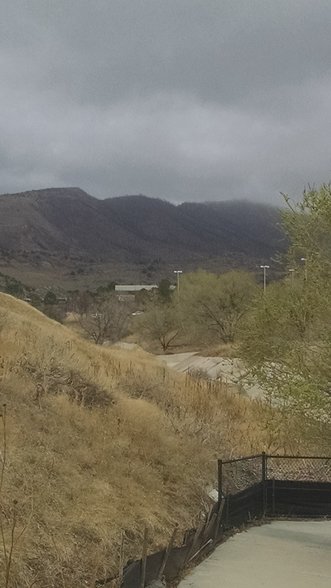 Today - Tuesday - something big might be blowing our way - hopefully snow! Today - Tuesday - something big might be blowing our way - hopefully snow! My writing season began earlier. In December, I enjoyed a blast of creativity. I am still harvesting the story ideas now. I just finished a short story. I'm beginning an exciting new novel project that I'll talk more about later. This weather reminds me that you have to take advantage of nice days when they happen, and be prepared to ride out the inevitable storms. It often seems that things don't happen in our timing. No, the good and the bad arrive on their own schedule. I hope you are enjoying spring. The weather can be tumultuous, and sometimes you just don't know what to expect from day to day. Through it all, though, there is that delicious smell of thawing earth and emerging vegetation. The cycle begins again. 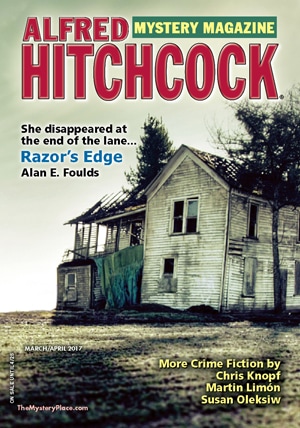 Don't confuse graphic fiction with comic books. Although both use illustrations to tell a story, graphic fiction might be considered an elevated version, or comics all grown up. Manga is Japanese graphic fiction. Anime is the movie version of manga. Our younger daughter (mid-twenties) and grandchildren are happy participants in the great love affair between American youth and Japanese culture. They devour illustrated fiction appropriate to their reading levels and ages. Some manga is more like the classic comic book, while other stories may be dark and complex, geared toward mature readers. Family friend Jason Salas creates graphic fiction in comic strip style, with two to five panels telling a story. One series, Perk at Work, follows quirky characters who work at or frequent a coffee shop. This is all to say that I am familiar with graphic fiction. I don't seek it out, but it frequently finds its way into my reading. I am not a snob about the art form, seeing both its appeal and value. When I saw graphic fiction featured in the March/April 2017 issue of Alfred Hitchcock Mystery Magazine, I was eager to see what an artist and writer could do with the mystery fiction short story format. Dale Berry's Dead Air follows a radio disc jockey as he takes a listener's phone call. The illustrations are vital to the tale, creating atmosphere, and also giving the big reveal at the end. The story is brief, so if I say too much, I'll give away the mystery. I'll just tell you, whether you are a graphic fiction fan or not, this story is worth reading. You can learn about Berry's process in combining writing a mystery fiction story while using illustration. If you prefer your fiction with less visual art and more prose, visit the website Trigger Warning to read short fiction with one illustration. 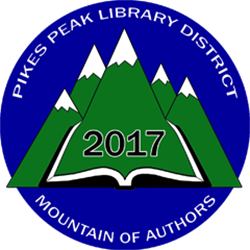 On April 8, I will be participating in a library event, Mountain of Authors. Date: Saturday, April 8, 2017 Time: 11 a.m. – 5 p.m. Location: Library 21c map it! The 11th Annual Mountain of Authors (MOA) is a free annual community program that provides an opportunity for the public and local authors to meet and listen to notable authors and writers, and for aspiring writers to learn more about the craft of writing. 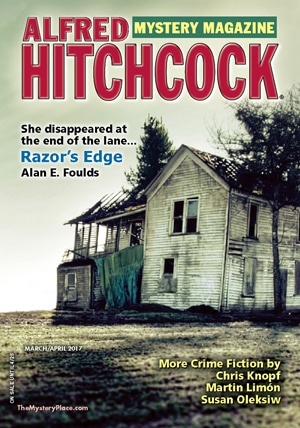 The March/April 2017 issue of Alfred Hitchcock Mystery Magazine arrived, and I pounced on it. Listed on the cover is an author I enjoy reading, Martin Limon. Inside, I discovered an author new to me, Charles John Harper. Both tales ended with astonishing revelations and intriguing questions. There the similarity ends, as Limon's Hominid is set in Mongolia, while Harper's The Echoes takes place in rural Minnesota. I have followed Limon's character Il-yong through adventures before. The half-Korean, half-American private detective operates outside of Beijing authority. A client meets Il-yong at a coffee shop, offering him a pile of money to find her husband. So far, fairly standard PI parameters - the pretty female in trouble, a somewhat shady investigator for hire. As they take off in a private Learjet, Il-Yong wishes he had negotiated a higher fee. Then Hominid veers off in its own direction as the two head deep into the wilderness. Mrs. Korahm's missing husband is a paleontologist chasing the rumor of ancient humans in the remote Altai Mountains. The story is a mystery, and clues are presented. However, the ending does not contain a neat solution. You are left to decide what really happened, although I have my own opinion. In an entirely different setting, but with an equally interesting ending, Harper's main character is recently widowed Pope County Sheriff Dan Parrish. The pain of his loss washes the story in gray. Setting descriptions are beautifully done, dropping the reader effectively into the Minnesota woods. Harper's neighbor is dead. He suspects her creepy lawyer husband. Parrish diligently searches for the clues that will implicate the obviously guilty husband. A lazy coroner makes his job more difficult, as Parrish oversees the autopsy, giving advice on what to look for to the reluctant doctor. The ending leaves questions, as in Limon's Hominid. In The Echoes, I wondered what the characters would do next, although I had an idea of how things might go. In Hominid, the questions were more a choice about which scenario you were willing to believe. 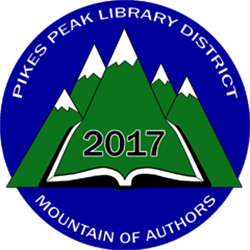 Last week, my post on marketing appeared on P J Nunn's website, Bookbrowsing. Plenty of authors can give advice on how to market your fiction. I am more of the opinion that your best marketing is writing and publishing that next great book. But we all have to make some effort to get our names and our books seen by readers. I share my thoughts on P J's blog. One thing I do enjoy is taking part in local library events. I have loved libraries since I was old enough to hold a book. I'll be participating in Mountain of Authors, a Pikes Peak library event April 8 featuring local authors. 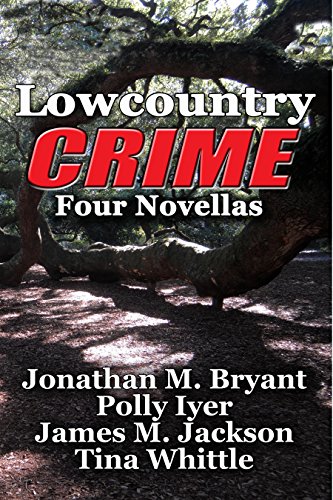 I did not venture out this past week any further than the southern settings in the four novella collection, Lowcountry Crime. Next up is Polly Iyer with her story, The Last Heist. But is it? Iyer's setting is also in the southeastern USA, in the city of Charleston. Paul Swan, a professional jewel thief, against his self-imposed rule, risks a heist in his home town. He promises himself this is the last job before he retires. After a successful career, this theft seems to come off like all the rest. That's when the action cranks up. I wanted to spend more time with these characters, and apparently you can. Like Whittle's story, this is a prequel to novels in a series. A good anthology has variety, while sticking to a unified theme. Lowcountry Crime does this well. Tina Whittle's tale involves the lower end of the social spectrum, and takes us to the swamps. Iyer's characters move in a higher social stratum, among the rich and powerful in a city setting. I am halfway through Blue Nude, where Jonathan M. Bryant's character Brad Sharpe takes us to an island in an attempt to clear his name. Enjoyable reads, good writing by a variety of authors, and an entertaining setting. I'll have to check out more anthologies! 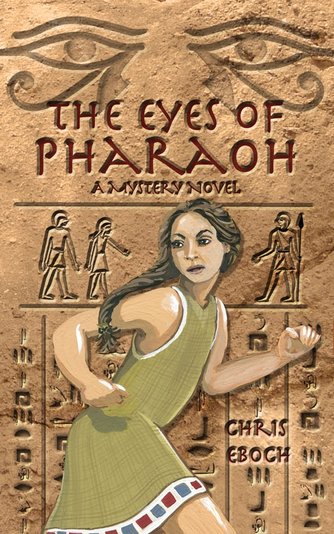 My guest today is Chris Eboch, author of over 40 book for young people. Read about her newest release, The Eyes of the Pharaoh. In my experience, kids – and teachers – love ancient Egypt. It’s long ago and far away, and yet somehow the personalities shine through the millennia and resonate with us today. A love poem from a young woman says, “My heart thought of my love of you when half of my hair was braided. I came at a run to find you and neglected my hairdo.” (What Life Was like on the Banks of the Nile, Time Life Books, page 36.) These windows into the past show us that the human soul has been much the same for 5000 years. I’ve tried to bring the world and people of ancient Egypt to life in my novel for young people, The Eyes of Pharaoh: When Reya hints that Egypt is in danger from foreign nomads, Seshta and Horus don’t take him seriously. How could anyone challenge Egypt? Then Reya disappears. To save their friend, Seshta and Horus spy on merchants, soldiers, and royalty, and start to suspect even The Eyes of Pharaoh, the powerful head of the secret police. Will Seshta and Horus escape the traps set for them, rescue Reya, and stop the plot against Egypt in time?” The Eyes of Pharaoh is ideal for use in elementary and middle school classrooms or by homeschooling students studying ancient Egypt. Suzanne Borchers says, “I teach a gifted class of fourth and fifth graders. Using this historical fiction is a window into Ancient Egypt – its people, culture, and beliefs. My class enjoyed doing research on Egyptian gods and goddesses, and hieroglyphs. Projects extended their knowledge of this fascinating time and place. I also highly recommend it for its fast paced plot, interesting and ‘real’ characters, and excellent writing.” To help teachers and homeschooling parents, extensive Lesson Plans provide material aligned to the Common Core State Standards. You’ll find discussion questions, persuasive letter and speech projects, journal questions, art projects, and a crossword puzzle. The Eyes of Pharaoh is available in paperback, hardcover, and e-book. It can be ordered from Amazon or other distributors. A Readers’ Favorite review said, “I found the book fascinating for many reasons…. The twists and turns in the plot make it a compelling read. The setting of the story shows the extensive research the author must have done to make it enjoyable to readers. The mystery that runs through the plot is intriguing and the images are vivid. The author does an excellent job by bringing ancient Egypt to life through this story and giving readers a lot of information about the beliefs that existed in society during that period, as well as the culture and history.” I hope many young people will experience the splendor of ancient Egypt through my book, while understanding the messages that still resonate today. 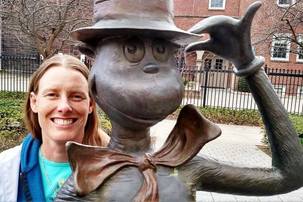 Chris Eboch is the author of more than 40 books for young people, including The Well of Sacrifice. This historical drama set in ninth-century Mayan Guatemala is used in many schools as supplemental fiction when students learn about the Maya. Kirkus Reviews said, “The novel shines not only for a faithful recreation of an unfamiliar, ancient world, but also for the introduction of a brave, likable and determined heroine.” The Eyes of Pharaoh is sure to reach readers in the same way. Ms. Eboch’s other titles include The Genie’s Gift, a middle eastern fantasy; the Haunted series, about kids who travel with a ghost hunter TV show; the fictionalized biographies Jesse Owens: Young Record Breaker and Milton Hershey: Young Chocolatier (part of Simon & Schuster’s Childhood of Famous Americans series); and many nonfiction titles. 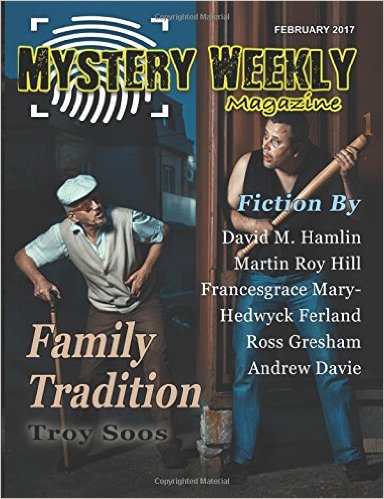 The Beech brothers Tommy and Donald cook up a scheme to steal cars by posing as valets in front of nice restaurants. Their plans, and the story, roll along predictably, until the action takes an unexpected turn. David M. Hamlin's tale appears in the February issue of Mystery Weekly Magazine. The characters are likable, and just smart enough to get themselves into a genuine mess. I enjoyed thinking I had the story figured out, then being taken on a wild ride by the Beech boys. |
Subscribe to this blog: |
Proudly powered by Weebly
 RSS Feed
RSS Feed